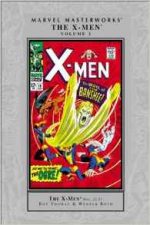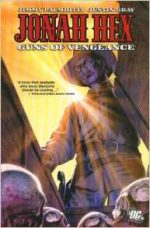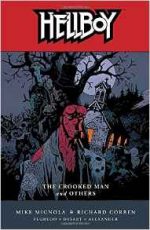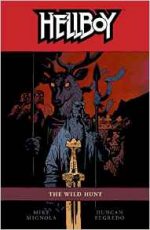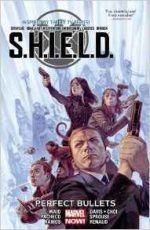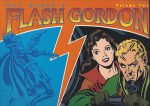
By Don Moore & Mac Raboy (Dark Horse)
ISBN: 978-1-56971-911-X
By almost every metric Flash Gordon is the most influential comic strip in the world. When the hero debuted on Sunday January 7th 1934 (with the superb Jungle Jim running as a supplementary “topper†strip) as an answer to the revolutionary, inspirational, but quirkily clunky Buck Rogers (by Philip Nolan & Dick Calkins and also began on January 7th albeit in 1929) two new elements were added to the wonderment; Classical Lyricism and poetic dynamism. It became a weekly invitation to stunningly exotic glamour and astonishing beauty.
Where Buck Rogers mixed traditional adventure with groundbreaking science concepts, Flash Gordon reinterpreted fairy tales, heroic epics and mythology, spectacularly draping them in the trappings of the contemporary future, with varying “Raysâ€, “Engines†and “Motors†substituting for trusty swords and lances – although there were also plenty of those – and exotic craft and contraptions standing in for galleons, chariots and magic carpets.
It was a narrative trick which made the far-fetched satisfactorily familiar – and one initially continued by Mac Raboy and Don Moore in their run of Sunday strips. Look closely though and you’ll see cowboys, gangsters and of course, flying saucer fetishes adding contemporary flourish to the fanciful fables in this second superb volume…
Most important of all, the sheer artistic talent of Raymond, his compositional skills, fine line-work, eye for clean, concise detail and just plain genius for drawing beautiful people and things, swiftly made this the strip that all young artists swiped from.
When original material comicbooks began a few years later, literally dozens of talented kids used the clean-lines of Gordon as their model and ticket to future success in the field of adventure strips. Almost all the others went with Milton Caniff’s masterpiece of expressionism Terry and the Pirates (and to see one of his better disciples check out Beyond Mars, illustrated by the wonderful Lee Elias).
Flash Gordon began on present-day Earth (which was 1934, remember?) with a wandering world about to smash into our planet. As global panic ensued, polo player Flash and fellow passenger Dale Arden narrowly escaped disaster when a meteor fragment downed their airliner. They landed on the estate of tormented genius Dr. Hans Zarkov, who imprisoned them in the rocket-ship he had built.
His plan? To fly the ship directly at the astral invader and deflect it from Earth by crashing into it…!
Thus began a decade of sheer escapist magic in a Ruritanian Neverland: a blend of Camelot, Oz and a hundred fantasy realms which promised paradise yet concealed hidden vipers, ogres and demons, all cloaked in a glimmering sheen of sleek futurism. Worthy adversaries such as utterly evil yet magnetic Ming, emperor of the fantastic wandering planet; myriad exotic races and shattering conflicts offered a fantastic alternative to drab and dangerous reality for millions of avid readers around the world.
With Moore doing the bulk of the scripting, Alex Raymond’s ‘On the Planet Mongo’ ran every Sunday until 1944, when the artist joined the Marines. On his return he forsook wild imaginings for sober reality: creating gentleman-detective Rip Kirby so the public’s unmissable weekly appointment with wonderment perforce continued under the artistic auspices of Austin Briggs – who had drawn the daily monochrome instalments since 1940.
In 1948, eight years after beginning his career drawing for the Harry A. Chesler production “shop†comicbook artist Emmanuel “Mac†Raboy took over illustrating the Sunday page. Moore remained as scripter and began co-writing with the new artist.
Raboy’s sleek, fine-line brush style – heavily influenced by his idol Raymond – had made his work on Captain Marvel Jr., Kid Eternity and especially Green Lama a benchmark of artistic quality in the early days of the proliferating superhero genre. His seemingly inevitable assumption of the extraordinary exploits led to a renaissance of the strip and in a rapidly evolving post-war world, Flash Gordon became once more a benchmark of timeless, hyper-real quality escapism which only Hal Foster’s Prince Valiant could touch.
This second 260-page paperback volume, produced in landscape format and printed in stark black-&-white (although one or two strips appear to have been scanned from printed colour copies) covers May 17th 1953 to February 23rd 1958 and opens with a scholarly Introduction on ‘Comic Strip Godfathers’ from Bruce Jones before the previous volume’s cliffhanger is addressed…
With a new spaceship, far-flung travellers Flash, Dale and Zarkov set off for Earth but are forced to land on the Moon where a secret human base had been established. For unknown reasons Dr. Stella and her thuggish aide Marc detain and delay them, but when an increasing number of close shaves and mysterious accidents occur, a little digging by our heroes reveals that they are the unwitting guests of ruthless space pirates…
After expediently dealing with the planetary privateers our heroes head for Earth, only to be promptly seconded to spearhead an urgent exploratory expedition to a newly discovered satellite body. Suitably dutiful, they hurtle off into the void again…
‘(Life on) Titan’ ran from 14th June to September 20th 1953 and details how the little world is populated by giants. However, after capturing one of the hulking inhabitants Zarkov is forced to conclude that the truth is far stranger than the Earthmen could have imagined…
The tireless boffin then builds a single-seater spaceship and required Flash to take a test run out to Jupiter’s moon ‘Callisto’ (27th September 1953 to 17th January 1954). A sudden illness causes the dauntless pilot to crash and Flash awakens in the care of elderly hermit Phylo, who cunningly embroils the troubleshooter in his own struggle against invisible psychic dictator The Mind…
After overthrowing the hidden tyrant the indomitable Earthman heads home and actually enjoys a little rest before an ancient mystery unfolds in ‘Flash Gordon and the Thanatos’ (17th January-2nd May).
After archaeologist Dr. Sark finds incontrovertible evidence of an atomic blast in the Libyan desert in prehistoric times, our ever-inquisitive action man uncovers an alien in a bottle but is too late to save Dale from being abducted by the mind-bending survivor of an antediluvian starship crash…
Dashing in pursuit as his beguiled beloved heads off-world, Flash is drawn into the parallel dimension or Cortinus where god-like beings dwell. They welcome the intruders from fondly-remembered Earth but are sadly unaware that one of the visitors carries the malevolent spirit of their outcast brother Loki…
Once freed the villain proudly boasts how he influenced and dominated many bellicose humans such as Alexander, Julius Caesar and Genghis Khan and now intends ruling two realms for his own benefit. Sadly for him, nigh-omnipotent Loki vastly underestimates the ingenuity and resolve of his mortal opponents…
With a ship donated by head deity Zustra, Flash and Dale re-cross the dimensional divide and arrive in deep space to encounter a scene of horrific barbarity at an Observatory Station. When the ‘Outlaw of the Asteroids’ (9th May-25th July) stole the outpost’s oxygen the crew almost died in hibernation. After pausing to revive the deep-frozen scientists the adventurers set off after the ruthless bandit and discover the reason for his heinous theft was both noble and desperate. The bandit perishes for his sins, but not before leaving young space orphan Pebbles with the only humans he can trust…
By the time Flash, Dale and Pebbles reach Earth the next exploit is already well underway as ‘The Star Tree’ (1st August-17th October) seed survives a meteor crash in the Amazon and immediately propagates itself in fertile soil. By the time our valiant wanderers accidentally land in the region, it has been transformed into an arctic wilderness where a gigantic plant is voraciously consuming every living thing its grasping branches can seize…
The vegetable invasion is no accident and as Flash leads the frozen rain forest’s native inhabitants in spirited resistance, cold-blooded aliens appear. They lived on Earth when it was a giant ice ball and after eons on Pluto want their original world back…
They would have succeeded too, had not one of the invaders found his heart warming to the plight of the disputed world’s current tenants…
With that threat ended normality returns but soon after packing Pebbles off to boarding school Flash, Zarkov and many other unsuspecting Earth folk are shanghaied by eerie metal globes and transported to ‘The Lonely Planet!’ (24th October 1954 to 9th January 1955)…
Here Herculean extraterrestrial barbarians and wily midgets conspire and compete to find fresh fodder for gladiatorial contests, but with the aid of a usurped king, Flash quickly upsets the unlikely alliance and overthrows the twisted regime. However, just as the liberated Earthlings enter home orbit, their always-embattled birthworld is attacked by the insectoid Antomni who require a fresh colony to exploit. The bug beings expect little resistance as they posses the power of Time Migration…
The invaders travel millions of years ‘Into the Past’ (16th January-27th March) to prevent the evolution of humanity but accidentally catch Flash and Zarkov in their temporal backwash, allowing our heroes to inspire a band of dawn men to exterminate the insectoids before returning to their proper time and place…
Always restless, Zarkov then organises an exploratory expedition to ‘Venus’ (3rd April – 19th June) where Flash and Dale find a feudal civilisation in turmoil beneath the planet’s impenetrable cloud layers. Before long they are assisting scientific prodigy Viko and his fellow exiled “Mistiks†in overturning the oppressive, superstition-ruled authorities and introducing rational enlightenment to the Second Planet from the Sun…
Soon after, Africa is beset by a strange sleeping plague and investigations reveal the source is escaped gasses from an unsuspected ‘City Within the Earth’ (26th June – 28th August). The accident also allows toxic oxygen to contaminate the subterranean metropolis of Centra and when its bravest warriors surface to investigate, a concatenation of misfortunes compel them to take Flash captive. Imprisoned and soon to become the treasured possession of flamboyant Princess Amara, Gordon is rescued by the indomitable Dale who braves the depths and deadly air to save her man and seal off the underworld forever…
‘The Dark Planet’ (4th September – 6th November) has lurked undetected at the edge of the solar system for all of humanity’s history but that occlusion ends when murderers Stragg, Rust and Tula are exiled from their advanced culture on the distant world of Ur and dumped on the frigid world.
When Flash, Dale and Zarkov’s planetary mapping mission brings them to the bleak outpost they are ambushed by the killers who then steal their ship. The aliens have never encountered human sneakiness though, and are soon back where they started and engaged in a lethal duel for control of the ship and their liberty…
Human trafficking underpins the saga of ‘Station Crossroads’ (13th November 1955 – 15th January 1956) as our heroes stumble upon a scheme to kidnap and sell human technicians to scientifically backward aliens. The vile human mastermind behind the plot operates out of Earth’s most popular orbital rest-stop but before the slavers are finally crushed Flash discovers a close friend is deeply involved in the abductions…
When Gordon discovers a hidden base at Earth’s North Pole is being used by aquatic aliens he becomes embroiled in an ‘Arctic adventure’ (22nd January-March 25th) where unscrupulous Earthmen use the freezing waters as a cost-free fish-farm to grow giant monsters for mysterious offworlders to consume…
After a far-distant world experiences an atomic accident the aftermath produces a voracious ‘Radioactive Man’ (1st April – 3rd June) who can only exist by absorbing deadly fallout. The authorities’ solution is to blast the mutant into the void where, after years of lonely travel, atomic exile Djonn Toth lands on the planet Rota just as Flash and Dale arrive for a visit.
Before long the humans’ vast troubleshooting experience is employed in defeating Toth’s efforts to enslave the population and consume all their radium…
When the fantastic planet’s eccentric orbit again intersects with Earth, Flash, Dale and Zarkov ‘Return to Mongo’ (10th June 1956 – 13th January 1957) for the first time in six years. However their proposed sightseeing trip inevitably involves them in an icily arctic cold war between Wolf Men and Walrus Men, a battle of wills with would-be supreme tyrant Gant, and clashes with leather-winged Dactyl Men.
This leads to capture by the arrogant cloud dwellers of Paxora where an outbreak of robot duplicates intent on conquest ends Mongo’s most secretive sub-culture. Upsetting the artificial men’s plan eliminates all but one of the inimical automatons, but ‘Rok’ (13th January – 10th March) is like no android the Earthlings have ever encountered before: both patronising protector and unstable enemy in one.
Although safeguarding the humans through the wildest regions of Mongo, the mechanoid’s ultimate aims are always unclear and his manner of demise most unexpected…
Brought to the edge of civilisation Flash, Dale and Zarkov enter a spaceship race, intent on winning a craft able to take them home to Earth, but the ‘Suicide Run’ (17th March-19th May) almost proves their undoing as most of the other competitors indulge in sabotage and subterfuge of every sort to secure the glittering prize…
Eventually victorious, our heroes ‘Escape from Mongo’ only to be lured into ‘The Space Tomb’ (26th May – 14th July) of nebula-dwelling desperado the Gatherer who wants to imprison them beside a legion of other valiant explorers in his vast Sargasso of Space. After outwitting the deranged collector the humans resume their homeward flight but are again diverted, this time by ‘The Space Genie’ (21st July-1st September): a fearsome yet affable, lethally literal-minded being who brings them to planetary paradise Superba.
The inhabitants are not pleased: they only just survived the Genie’s last visit and used all their ingenuity and wish-making ability to get rid of the interstellar pest…
Flash’s argosy home is then interrupted by a string of short interconnected adventures (‘Space Voyage/Strange World/The Wheel Men’: spanning 8th September to 24th November) detailing clashes with space moths, elastic primitives and woman-stealing whirling dervishes engaged in all-out war with sky-residing Gyromen. After brokering a lasting peace between the eccentric extraterrestrials, the humans finally reach Earth in a borrowed Flying Saucer only to fall prey to ‘The Mystery of the Lonely Crowds!’ (1st December 1957 through January 12th 1958). A telepathic plague of depression and rapidly-spreading isolation has an otherworldly cause but is not intended to be a menace. It still culminates in tragedy, however…
This second non-stop rollercoaster ride concludes with the merest start of ‘Missiles from Neptune’ (19th January 1958 to the cliffhanging last page of February 23rd) as the Tyrant of Neptune decides to impress the captive populace by testing his latest Weapons of Interplanetary Destruction against the Earth, prompting Flash and Co to go and discourage him…
Every week that he toiled on the strip Mac Raboy produced ever-more expansive artwork filled with distressed damsels, deadly monsters and all sorts of outrageous adventure that continued until the illustrator’s untimely death in 1967. Perhaps that was a kindness…
Raboy was the last of the great Golden Age romanticist pencillers; his lushly lavish, freely flowing adoration of the perfect human form was beginning to stale in popular taste (for example the Daily feature had already switched to the solid, chunky, He-Manly burly, realism of Dan Barry and Frank Frazetta) but here at least the last outpost of ethereally beautiful heroism and pretty perils prevailed, and thanks to Dark Horse you can visit as easily and often as Flash and Dale popped between planets, just by tracking down this book and the ones which followed…
© 2003 King Features Syndicate Inc. ™ Hearst Holdings, Inc. All Rights Reserved.


